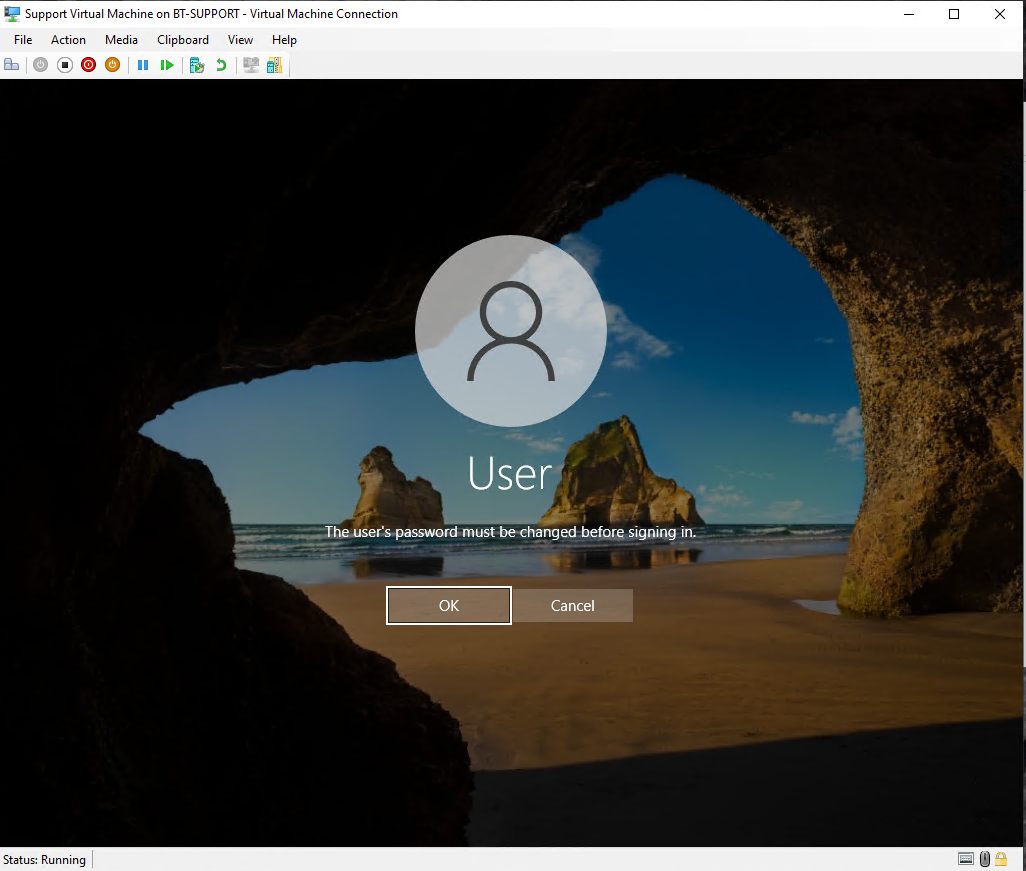Win10 installation autounattend.xml ungewollte passworteingabe
Hi zusammen,
Ich arbeite derzeit an einer Autoinstallation für Windows 10 unter Verwendung einer autounattend.xml.
Die Konfiguration funktioniert bislang reibungslos. Ich habe festgelegt, dass beispielsweise automatisch eine Partition erstellt und die Festplatte zuvor formatiert wird.
Des Weiteren habe ich eingestellt, dass ein Benutzer mit Administratorrechten angelegt wird. Für diesen Benutzer soll jedoch kein Passwort erforderlich sein. Im manuellen Installationsprozess von Windows kann ich normalerweise einen Benutzer ohne Passwort als lokalen Benutzer erstellen.
Bei meinem XML-Datei verläuft die Installation erfolgreich bis zum Abschluss des OOBE (Out-of-Box Experience) am Ende. Allerdings wird zum Schluss verlangt, dem Benutzer ein Passwort zuzuweisen.
Wie kann ich das verhindern?
Hier mein XML:

Ich arbeite derzeit an einer Autoinstallation für Windows 10 unter Verwendung einer autounattend.xml.
Die Konfiguration funktioniert bislang reibungslos. Ich habe festgelegt, dass beispielsweise automatisch eine Partition erstellt und die Festplatte zuvor formatiert wird.
Des Weiteren habe ich eingestellt, dass ein Benutzer mit Administratorrechten angelegt wird. Für diesen Benutzer soll jedoch kein Passwort erforderlich sein. Im manuellen Installationsprozess von Windows kann ich normalerweise einen Benutzer ohne Passwort als lokalen Benutzer erstellen.
Bei meinem XML-Datei verläuft die Installation erfolgreich bis zum Abschluss des OOBE (Out-of-Box Experience) am Ende. Allerdings wird zum Schluss verlangt, dem Benutzer ein Passwort zuzuweisen.
Wie kann ich das verhindern?
Hier mein XML:
<?xml version="1.0" encoding="utf-8"?>
<unattend xmlns="urn:schemas-microsoft-com:unattend">
<settings pass="windowsPE">
<component name="Microsoft-Windows-International-Core-WinPE" processorArchitecture="amd64" publicKeyToken="31bf3856ad364e35" language="neutral" versionScope="nonSxS" xmlns:wcm="http://schemas.microsoft.com/WMIConfig/2002/State" xmlns:xsi="http://www.w3.org/2001/XMLSchema-instance">
<SetupUILanguage>
<UILanguage>en-US</UILanguage>
</SetupUILanguage>
<InputLocale>0409:00000409</InputLocale>
<SystemLocale>en-US</SystemLocale>
<UILanguage>en-US</UILanguage>
<UILanguageFallback>en-US</UILanguageFallback>
<UserLocale>en-US</UserLocale>
</component>
<component name="Microsoft-Windows-Setup" processorArchitecture="amd64" publicKeyToken="31bf3856ad364e35" language="neutral" versionScope="nonSxS" xmlns:wcm="http://schemas.microsoft.com/WMIConfig/2002/State" xmlns:xsi="http://www.w3.org/2001/XMLSchema-instance">
<DiskConfiguration>
<Disk wcm:action="add">
<CreatePartitions>
<CreatePartition wcm:action="add">
<Type>Primary</Type>
<Size>300</Size>
<Order>1</Order>
</CreatePartition>
<CreatePartition wcm:action="add">
<Order>2</Order>
<Size>100</Size>
<Type>EFI</Type>
</CreatePartition>
<CreatePartition wcm:action="add">
<Order>3</Order>
<Type>MSR</Type>
<Size>128</Size>
</CreatePartition>
<CreatePartition wcm:action="add">
<Order>4</Order>
<Extend>true</Extend>
<Type>Primary</Type>
</CreatePartition>
</CreatePartitions>
<WillWipeDisk>true</WillWipeDisk>
<ModifyPartitions>
<ModifyPartition wcm:action="add">
<Order>1</Order>
<TypeID>DE94BBA4-06D1-4D40-A16A-BFD50179D6AC</TypeID>
<Label>WINRE</Label>
<Format>NTFS</Format>
<PartitionID>1</PartitionID>
</ModifyPartition>
<ModifyPartition wcm:action="add">
<Order>3</Order>
<PartitionID>3</PartitionID>
</ModifyPartition>
<ModifyPartition wcm:action="add">
<PartitionID>2</PartitionID>
<Order>2</Order>
<Label>System</Label>
<Format>FAT32</Format>
</ModifyPartition>
<ModifyPartition wcm:action="add">
<Order>4</Order>
<PartitionID>4</PartitionID>
<Label>OS</Label>
<Letter>C</Letter>
<Format>NTFS</Format>
</ModifyPartition>
</ModifyPartitions>
<DiskID>0</DiskID>
</Disk>
</DiskConfiguration>
<ImageInstall>
<OSImage>
<InstallTo>
<DiskID>0</DiskID>
<PartitionID>4</PartitionID>
</InstallTo>
<InstallToAvailablePartition>false</InstallToAvailablePartition>
</OSImage>
</ImageInstall>
<UserData>
<ProductKey>
<WillShowUI>Never</WillShowUI>
<Key>M7XTQ-FN8P6-TTKYV-9D4CC-J462D</Key>
</ProductKey>
<AcceptEula>true</AcceptEula>
<FullName>User</FullName>
</UserData>
</component>
</settings>
<settings pass="oobeSystem">
<component name="Microsoft-Windows-Shell-Setup" processorArchitecture="amd64" publicKeyToken="31bf3856ad364e35" language="neutral" versionScope="nonSxS" xmlns:wcm="http://schemas.microsoft.com/WMIConfig/2002/State" xmlns:xsi="http://www.w3.org/2001/XMLSchema-instance">
<AutoLogon>
<Password />
<Enabled>true</Enabled>
<Username>User</Username>
<LogonCount>1</LogonCount>
</AutoLogon>
<OOBE>
<VMModeOptimizations />
<HideEULAPage>true</HideEULAPage>
<HideOEMRegistrationScreen>true</HideOEMRegistrationScreen>
<HideOnlineAccountScreens>true</HideOnlineAccountScreens>
<HideWirelessSetupInOOBE>true</HideWirelessSetupInOOBE>
<NetworkLocation>Home</NetworkLocation>
<SkipMachineOOBE>true</SkipMachineOOBE>
<SkipUserOOBE>true</SkipUserOOBE>
<ProtectYourPC>3</ProtectYourPC>
</OOBE>
<UserAccounts>
<LocalAccounts>
<LocalAccount wcm:action="add">
<Password />
<DisplayName>User</DisplayName>
<Group>Administrators</Group>
<Name>User</Name>
</LocalAccount>
</LocalAccounts>
</UserAccounts>
<RegisteredOwner>User</RegisteredOwner>
<DisableAutoDaylightTimeSet>false</DisableAutoDaylightTimeSet>
<FirstLogonCommands>
<SynchronousCommand wcm:action="add">
<Order>1</Order>
<CommandLine>reg add "HKEY_CURRENT_USER\Software\Microsoft\Windows\CurrentVersion\Explorer\ControlPanel" /v StartupPage /t REG_DWORD /d 1 /f</CommandLine>
<RequiresUserInput>true</RequiresUserInput>
<Description>Control Panel View</Description>
</SynchronousCommand>
<SynchronousCommand wcm:action="add">
<Description>Control Panel Icon Size</Description>
<Order>2</Order>
<CommandLine>reg add "HKEY_CURRENT_USER\Software\Microsoft\Windows\CurrentVersion\Explorer\ControlPanel" /v AllItemsIconView /t REG_DWORD /d 0 /f</CommandLine>
<RequiresUserInput>false</RequiresUserInput>
</SynchronousCommand>
<SynchronousCommand wcm:action="add">
<Order>3</Order>
<RequiresUserInput>false</RequiresUserInput>
<CommandLine>cmd /C wmic useraccount where name="User" set PasswordExpires=false</CommandLine>
<Description>Password Never Expires</Description>
</SynchronousCommand>
</FirstLogonCommands>
<TimeZone>W. Europe Standard Time</TimeZone>
</component>
</settings>
<settings pass="specialize">
<component name="Microsoft-Windows-International-Core" processorArchitecture="amd64" publicKeyToken="31bf3856ad364e35" language="neutral" versionScope="nonSxS" xmlns:wcm="http://schemas.microsoft.com/WMIConfig/2002/State" xmlns:xsi="http://www.w3.org/2001/XMLSchema-instance">
<InputLocale>0409:00000409</InputLocale>
<SystemLocale>en-US</SystemLocale>
<UILanguage>en-US</UILanguage>
<UILanguageFallback>en-US</UILanguageFallback>
<UserLocale>en-US</UserLocale>
</component>
<component name="Microsoft-Windows-Security-SPP-UX" processorArchitecture="amd64" publicKeyToken="31bf3856ad364e35" language="neutral" versionScope="nonSxS" xmlns:wcm="http://schemas.microsoft.com/WMIConfig/2002/State" xmlns:xsi="http://www.w3.org/2001/XMLSchema-instance">
<SkipAutoActivation>true</SkipAutoActivation>
</component>
<component name="Microsoft-Windows-SQMApi" processorArchitecture="amd64" publicKeyToken="31bf3856ad364e35" language="neutral" versionScope="nonSxS" xmlns:wcm="http://schemas.microsoft.com/WMIConfig/2002/State" xmlns:xsi="http://www.w3.org/2001/XMLSchema-instance">
<CEIPEnabled>0</CEIPEnabled>
</component>
<component name="Microsoft-Windows-Shell-Setup" processorArchitecture="amd64" publicKeyToken="31bf3856ad364e35" language="neutral" versionScope="nonSxS" xmlns:wcm="http://schemas.microsoft.com/WMIConfig/2002/State" xmlns:xsi="http://www.w3.org/2001/XMLSchema-instance">
<AutoLogon>
<Password />
</AutoLogon>
<ClientApplications />
<DesktopOptimization />
<Display />
<NotificationArea>
<PromotedIcon1 />
<PromotedIcon2 />
</NotificationArea>
<OEMInformation />
<OEMWelcomeCenter />
<OEMWelcomeCenterLinks />
<StartPanelLinks />
<StartTiles>
<LockScreen>
<Badge />
</LockScreen>
<WideTiles>
<WideTile1 />
<WideTile2 />
<WideTile3 />
<WideTile4 />
<WideTile5 />
<WideTile6 />
</WideTiles>
<SquareTiles>
<SquareTile1 />
<SquareTile2 />
<SquareTile3 />
<SquareTile4 />
<SquareTile5 />
<SquareTile6 />
<SquareTile7 />
<SquareTile8 />
<SquareTile9 />
<SquareTile10 />
<SquareTile11 />
<SquareTile12 />
<SquareOrDesktopTile1 />
<SquareOrDesktopTile2 />
<SquareOrDesktopTile3 />
<SquareOrDesktopTile4 />
<SquareOrDesktopTile5 />
<SquareOrDesktopTile6 />
<SquareOrDesktopTile7 />
<SquareOrDesktopTile8 />
<SquareOrDesktopTile9 />
<SquareOrDesktopTile10 />
<SquareOrDesktopTile11 />
<SquareOrDesktopTile12 />
</SquareTiles>
<RegionalOverrides />
</StartTiles>
<TaskbarLinks />
<Themes />
<WindowsFeatures />
<ComputerName>SN-2023</ComputerName>
<ProductKey>M7XTQ-FN8P6-TTKYV-9D4CC-J462D</ProductKey>
</component>
</settings>
<settings pass="offlineServicing">
<component name="Microsoft-Windows-LUA-Settings" processorArchitecture="amd64" publicKeyToken="31bf3856ad364e35" language="neutral" versionScope="nonSxS" xmlns:wcm="http://schemas.microsoft.com/WMIConfig/2002/State" xmlns:xsi="http://www.w3.org/2001/XMLSchema-instance">
<EnableLUA>false</EnableLUA>
</component>
</settings>
<settings pass="generalize">
<component name="Microsoft-Windows-Security-SPP" processorArchitecture="amd64" publicKeyToken="31bf3856ad364e35" language="neutral" versionScope="nonSxS" xmlns:wcm="http://schemas.microsoft.com/WMIConfig/2002/State" xmlns:xsi="http://www.w3.org/2001/XMLSchema-instance">
<SkipRearm>1</SkipRearm>
</component>
</settings>
<cpi:offlineImage cpi:source="catalog://bt-support/cusers/user/desktop/autoinstall_win10/install_windows 10 iot enterprise ltsc 2021.clg" xmlns:cpi="urn:schemas-microsoft-com:cpi" />
</unattend>
Bitte markiere auch die Kommentare, die zur Lösung des Beitrags beigetragen haben
Content-ID: 93233603416
Url: https://administrator.de/forum/win10-installation-autounattend-xml-ungewollte-passworteingabe-93233603416.html
Ausgedruckt am: 30.07.2025 um 16:07 Uhr
5 Kommentare
Neuester Kommentar
Des Weiteren habe ich eingestellt, dass ein Benutzer mit Administratorrechten angelegt wird. Für diesen Benutzer soll jedoch kein Passwort erforderlich sein.
OMG, wozu dann überhaupt Userkonten 🤪<Password>
<Value></Value>
<PlainText>true</PlainText>
</Password>Gruß Katrin